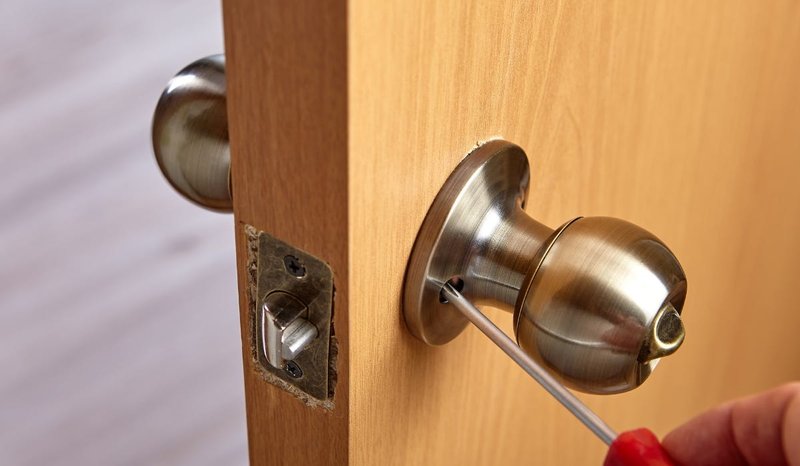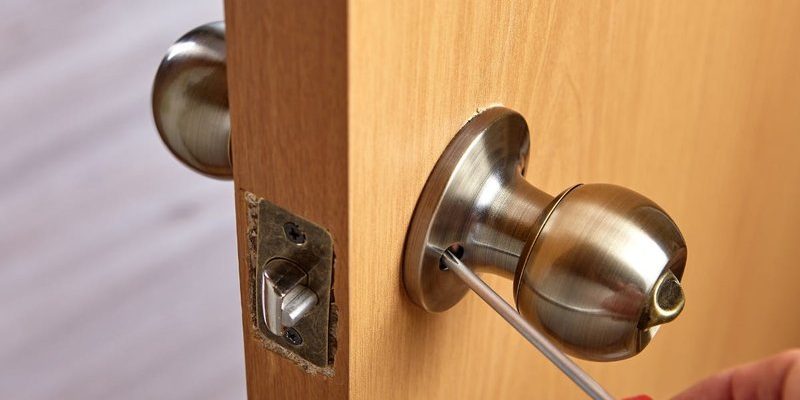
This happens whether you have a budget doorknob, a top-shelf brand like Schlage, or even a fancy smart lock with a battery-powered remote. Sometimes, locks feel much smoother on the inside door handle than the outside, making things even more confusing. So, what’s actually going on inside that lock to make it stiff up after a break, and what can you do about it?
Let’s get into the surprising reasons why your exterior door hardware seizes up after sitting idle—and what you can do to keep things turning smoothly year-round, no matter which brand or design you have.
What Makes Door Hardware Get Stiff In The First Place?
Honestly, most of us take our locks and handles for granted—until they decide to give us grief. Think of your door hardware like the gears on an old bike: if you keep pedaling, things usually stay smooth. But if you park the bike for a month, dust and gunk build up, and suddenly the gears are tough to shift.
Your exterior door hardware is filled with moving parts: tiny springs, pins, and latches that all need to move in just the right way when you turn the key or push the handle. When these parts aren’t moving regularly, friction starts to win. Old lubricant dries out, dust settles in, and even a little rust can start to creep up. The longer you leave it, the tougher things get.
Here’s the thing—every brand and style is a little different. Some Schlage or Kwikset locks have special anti-corrosion coatings, while generic models might not. But all hardware is vulnerable to the same basic problem: inactivity gives grime and moisture a chance to settle in.
How Moisture & Weather Mess With Your Exterior Door Hardware
You might be wondering: why does exterior hardware get stiff, but interior handles keep working fine? The answer is right outside your front door. Outdoor locks face down rain, snow, humidity, and wild temperature swings—stuff your pantry doorknob never has to worry about.
Whenever moisture sneaks into your lock or handle (and it always finds a way), it can stick around. In humid climates or winter, condensation forms inside the mechanism. That moisture reacts with metal parts, causing surface rust or swelling in certain plastics and lubricants. Even top-tier brands like Yale or August smart locks can’t totally escape this slow, sneaky attack.
Over time, parts can seize up, especially if a battery-powered remote or keypad doesn’t get used and the “self-cleaning” effect of regular movement is gone. That’s why you may notice hardware getting stiff after a rainy season, a heat wave, or when you return from vacation.
How Old Lubrication Can Turn Into Sticky Gunk
Let me explain: every lock and handle from the simplest latch to a high-tech smart lock needs some kind of lubricant inside. Lubricants keep metal bits gliding instead of grinding. But not all lubricants age gracefully. Some, like cheap greases or silicone sprays, get thick and gummy over time—especially if the hardware isn’t used.
When a lock sits there untouched, any old lubricant starts to collect dust, pollen, and gritty debris. Eventually, this turns into a sludge that actually blocks movement instead of helping it. You’ll feel it: the key gets hard to turn, or the handle barely budges. If you use a remote or keypad, the code might still work, but the hardware inside is straining to move.
Older homes and vacation properties tend to have this problem more often. The good news is, fresh lubricant—applied the right way—can bring even the stiffest hardware back to life. The key (pun intended) is using a dry lubricant or graphite powder instead of sticky oils that attract dust.
Corrosion, Rust, and Dirt: The Villains Inside Your Lock
Rust sounds dramatic, but it’s actually pretty sneaky. Think of it like plaque in your teeth: you don’t always see it, but it builds up quietly, especially when moisture is involved. When iron or steel parts inside your lock meet air and water, even a tiny bit, they start to oxidize. That means rough, gritty friction where smooth movement used to be.
Dirt is another enemy. Every time you or your family comes home and touches the lock or handle, you transfer grime, oil, and pollen from your hands. Add to that the dirt and dust blowing in the wind—and over time, even the best-made Schlage smart lock or code keypad can jam up.
If you notice a powdery red, orange, or green residue on your hardware, that’s rust or corrosion taking hold. The longer it sits, the harder it is to fix—so it pays to catch early.
Why Inactivity Makes The Problem Worse
Here’s the part that trips up a lot of people. You might think, “If I don’t use the lock, at least I’m not wearing it out, right?” In reality, locks, latches, and even remote-controlled smart locks *need* regular use to stay healthy—just like your muscles need exercise to stay flexible.
When you use the hardware, metal parts glide over each other, spreading lubricant and knocking loose tiny bits of grit or rust. If you let a lock or handle sit unused, everything settles. Lubricant dries up, dirt packs in, and rust can form exactly where there’s no motion to “self-clean” the surfaces. That’s why vacation homes, guest doors, or outdoor storage rooms are so often the first to seize up.
If you skip using your lock for a long while, you may also find the battery on a smart lock or remote has drained—adding a fresh troubleshooting headache on top of the stiffness.
How To Fix Stiff Exterior Door Hardware (And Keep It Working)
Thankfully, most stiff exterior door hardware can be fixed without calling a locksmith. The trick is to work slowly, use the right products, and avoid easy mistakes. Here’s a simple breakdown:
- Clean the hardware: Wipe down the outside of the lock and handle with a damp cloth to remove surface grime.
- Apply lubricant: Use a dry graphite lubricant or a spray made specifically for locks (not WD-40 or greasy oils).
- Work the mechanism: Insert the key and turn it back and forth several times. If you have a keypad or remote code lock, press the handle or latch repeatedly to spread the lubricant.
- Check batteries: For smart locks or remotes, swap in fresh batteries to rule out power issues.
- Inspect for visible rust: If you see rust, a bit of fine steel wool can help. Severe corrosion may mean it’s time for a replacement.
If you’re not sure what kind of lubricant to use, brands like Kwikset and Schlage often recommend graphite powder. Avoid anything that stays wet or sticky inside the lock—it attracts more dirt over time.
How Smart Locks And Keypad Locks Compare To Regular Ones
You might be wondering if a smart lock or remote code lock gets stiff less often than an old-school tumbler. The honest answer: it depends. Smart locks from brands like Schlage, Yale, or August have motorized parts, which means less manual movement most of the time. But those moving parts still need lubrication, and they can get stuck just like a classic deadbolt if left unused.
The difference is, with smart locks, you might first notice problems as error messages, reset issues, or trouble syncing the battery remote before the mechanism seizes up completely. Mechanical locks, on the other hand, get physically harder to turn or simply won’t budge. Both systems benefit from a little routine attention—even just pushing the handle and entering the code every week or two helps.
If your smart lock feels stiff *and* starts giving pairing or code errors, troubleshoot both the mechanical parts and the software—sometimes, one can hide the other’s issues.
Tips For Keeping Your Exterior Door Hardware In Good Shape
Let me share a few practical habits. It doesn’t take fancy tools or much know-how to keep your locks and handles running smoothly:
- Use every lock regularly: Even if it’s just a quick turn, regular use prevents things from seizing up.
- Clean and lubricate twice a year: Spring and fall are perfect times for a quick checkup.
- Inspect after storms or heavy weather: Wipe away any moisture and debris that could speed up corrosion.
- Swap batteries in smart locks before they fail: This avoids frustrating lockouts and reduces strain on the motor.
- If a lock feels stiff, act early: Don’t force the key—stop and lubricate before real damage happens.
These simple steps work for all types—whether you have a traditional deadbolt, a universal remote code lock, or the latest smart keypad from your favorite brand.
When Should You Replace Versus Repair Door Hardware?
Sometimes, even your best efforts won’t bring a lock back from the dead. Honestly, if you’ve cleaned, lubricated, and tried everything but the hardware still feels gritty or refuses to move, replacement might be your best bet.
Here’s how to judge:
- If you see deep rust, cracks, or parts that wobble, it’s probably time for a new lock.
- If the remote or code function keeps glitching even after new batteries and resets, the internal electronics may be failing.
- Modern locks, especially with smart features, aren’t always worth fixing beyond a certain point—the cost of troubleshooting can outweigh a simple swap.
Most brands offer easy DIY installation, so you don’t need to be a pro. And regular maintenance on your new hardware keeps this annoying stiffness from coming back.
Bringing It All Together: Stiff Locks Are a Fixable Frustration
Exterior door hardware getting stiff after sitting unused is a pretty common—and fixable—headache. Whether you’ve got a Schlage smart lock, a battered old deadbolt, or a slick new remote code entry system, the main culprits are always the same: weather, moisture, dust, and a lack of regular movement. With a little attention, the right lubricant, and the occasional battery swap, you’ll keep your door hardware working smoothly for years to come. So the next time your lock refuses to budge after a long break, you’ll know exactly what’s going on—and what to do about it.
